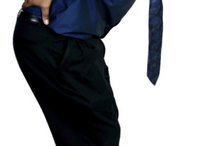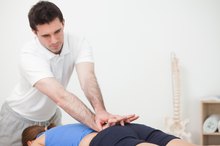Spinal Stenosis Symptoms in C6 & C7
Spinal stenosis causes narrowing of the bones that make up the spinal canals, or the areas through which the spinal cord and spinal nerves pass. The Mayo Clinic reports that spinal stenosis causes symptoms only when the spinal nerves or spinal cord are compressed. Depending on the cause of spinal stenosis, symptoms may gradually become worse over time. Spinal stenosis in the neck is called cervical spinal stenosis. C6 and C7 are two vertebrae in the cervical spine that may be affected by spinal stenosis.
Arm and Shoulder Pain
Cervical spinal stenosis that causes nerve compression can result in upper body pain. The University of Wisconsin reports that someone who has stenosis at the C6 and C7 levels may feel this pain in the shoulders, outer part of the upper and lower arm, and even into the hand--portions of the thumb, index and middle fingers, in particular. This pain is called radiculopathy. Because spinal stenosis does not always occur evenly on both sides of the body, this pain may be worse in one arm or shoulder. MedlinePlus reports that pain may be worse when standing: Cervical spinal stenosis pain may be relieved by sitting or leaning forward.
- Cervical spinal stenosis that causes nerve compression can result in upper body pain.
- MedlinePlus reports that pain may be worse when standing: Cervical spinal stenosis pain may be relieved by sitting or leaning forward.
Tingling or Numbess
C4 and C5 Nerve Damage Symptoms
Learn More
Cervical spinal stenosis may cause numbness or tingling sensations. Depending on the nerves involved, the University of Maryland Medical Center reports that this altered sensation (also called parasthesias) may be present in other parts of the body as well. If the sensory nerves entering or exiting the spinal cord at the C6 or C7 levels are affected, parasthesias may be present in the neck, shoulders and outer arms. Parasthesias may also extend to the thumb, index or middle finger. However, if the spinal cord is compressed at this level, parasthesias may be present in the legs as well. Like cervical stenosis pain, this numbness or tingling may be worse on one side of the body.
- Cervical spinal stenosis may cause numbness or tingling sensations.
- Depending on the nerves involved, the University of Maryland Medical Center reports that this altered sensation (also called parasthesias) may be present in other parts of the body as well.
Arm or Leg Weakness
Cervical spinal stenosis can cause both upper body and lower body weakness, according to the University of Maryland Medical Center. Compression of the nerves at the C6 and C7 levels may affect certain muscles in the upper body--in particular, those that straighten the arms (triceps), bend the fingers (finger flexors) and allow the palms to turn up (forearm pronators). Someone with spinal stenosis at these levels may have difficulty with these movements or may not be able to move these muscles at all, depending on how severe the nerve compression is. Spinal cord compression from cervical stenosis at C6 and C7 may also affect the leg muscles. Like other spinal stenosis symptoms, weakness may be worse on one side of the body.
- Cervical spinal stenosis can cause both upper body and lower body weakness, according to the University of Maryland Medical Center.
- Spinal cord compression from cervical stenosis at C6 and C7 may also affect the leg muscles.
Spasticity
L4/L5 Bulging Disc Symptoms
Learn More
Cervical spinal stenosis can cause other nerve problems in addition to those mentioned above. One of those, according to the University of Maryland Medical Center, is muscle spasticity. Muscle spasticity can cause spasms in the legs or make them more difficult to control. Other related problems include heightened reflexes in the legs and difficulty standing or walking.
- Cervical spinal stenosis can cause other nerve problems in addition to those mentioned above.
Related Articles
References
- Mayo Clinic: Spinal Stenosis Symptoms
- MedlinePlus: Spinal Stenosis
- University of Maryland Medical Center: Cervical Spinal Stenosis
- American College of Rheumatology. Spinal Stenosis. Updated March 2019.
- American Academy of Orthopaedic Surgeons. Lumbar Spinal Stenosis. Updated December 2013.
- Lee SY, Kim T-H, Oh JK, Lee SJ, Park MS. Lumbar Stenosis: A Recent Update by Review of Literature. Asian Spine J. 2015 Oct;9(5):818-28. doi:10.4184/asj.2015.9.5.818
- Akhavan-Sigari R, Rohde V, Alaid A. Cervical Spinal Canal Stenosis and Central Disc Herniation C3/4 in a Man with Primary Complaint of Thigh Pain. J Neurol Surg Rep. 2013 Dec;74(2):101-4. doi:10.1055/s-0033-1349202
- Takenaka S et al. Neurological Manifestations of Thoracic Myelopathy. Arch Orthop Trauma Surg. 2014 Jul;134(7):903-12. doi:10.1007/s00402-014-2000-1
- American College of Rheumatology. Spinal Stenosis. Updated March 2019.
- Issack PS, Cunningham ME, Pumberger M, Hughes AP, Cammisa FP. Degenerative lumbar spinal stenosis: evaluation and management. J Am Acad Orthop Surg. 2012;20(8):527-35. doi:10.5435/JAAOS-20-08-527
Resources
Writer Bio
Erica Jacques is an occupational therapist and freelance writer with more than 15 years of combined experience. Jacques has been published on Mybackpaininfo.com and various other websites, and in "Hope Digest." She earned an occupational therapy degree from Queen Margaret University in Edinburgh, Scotland, giving her a truly global view of health and wellness.









